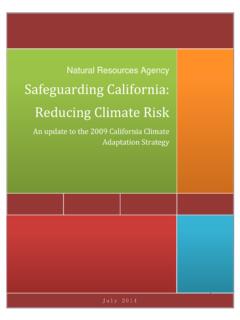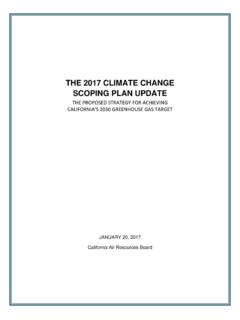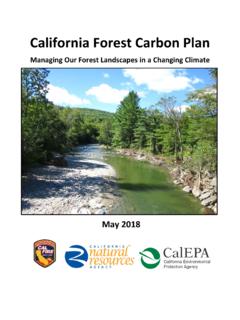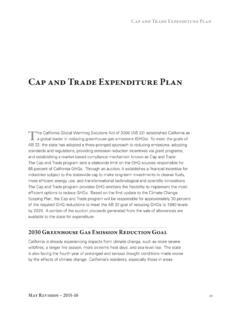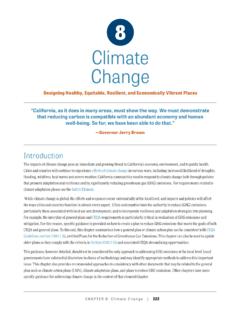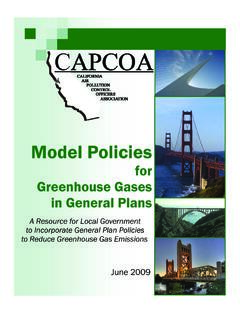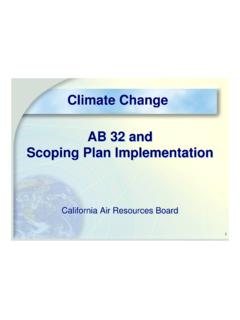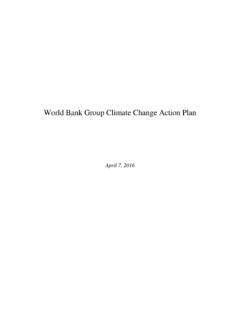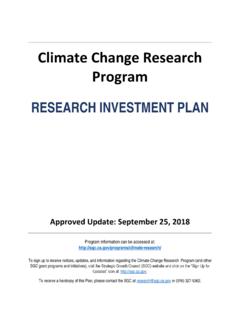Transcription of Written testimony for the Joint Legislative Committee on ...
1 Written testimony for the Joint Legislative Committee on climate change Policies June 9, 2017 Michael W. Wara Associate Professor, Stanford Law School Faculty Affiliate, Woods Institute for the Environment Thank you for the opportunity to testify on the issues of economic modeling of the 2030 Target scoping plan and related policy proposals before the Joint Legislative Committee . I am honored to participate in this first hearing of the Committee . For context, I am a longtime academic observer of California s energy and climate policies. I have spent over a decade conducting research on state, federal, and international climate policy with a particular focus on the design and implementation of emissions trading systems and their impact on the electricity sector. I have, in collaboration with Danny Cullenward and others, worked extensively on the development of modeling assessments of the impacts of federal carbon pricing proposals on behalf of their sponsors.
2 I have also worked extensively on legal issues that affect the application of state climate policies to interstate markets for electricity and transportation fuels. Because I have already commented extensively in the ARB cap and trade regulatory amendments process and in the ARB 2030 scoping plan Update process on the issues that the Committee has asked me to testify to, I include relevant excerpts from this testimony below. In particular, in comment letters to ARB, my colleague, Danny Cullenward and I have repeatedly called on ARB to undertake explicit assessment of policy robustness in the face of uncertainty, to employ energy-economic modeling to estimate expected carbon prices consistent with SB 32 s 2030 Target, and to explain how cap-and-trade with unlimited banking will actually produce quantity certainty consistent with SB 32 s goals.
3 While some of the details of the policy design proposed by ARB have evolved since these comments were Written , it is a fair assessment to say that the basic concerns outlined below remain largely unaddressed in the current version of the scoping plan Update and in the ISOR for the cap and trade regulatory amendments. An excerpt from Michael Wara and Danny Cullenward s letter to CARB on the Public Workshop on the 2030 Target scoping plan (November 7, 2016) 1. Policy Robustness A policy is robust if it is can be expected to perform well under a range of future conditions. The best way to design robust carbon policy is to test its performance and effects against a wide range of possible future scenarios. In contrast, the worst way to design robust carbon policy is to test its performance and effects against a single baseline scenario because this information cannot speak to how the policy portfolio will operate as future conditions depart from the policymaker s point forecast.
4 These risks are especially significant when trying to forecast the trajectory of an entire economy over a period of more than ten 1 Vaclav Smil, Perils of Long Range Forecasting: Reflections on Looking Far Ahead, Technological Forecasting & Social change 65: 251-64 (2000); Michael Wara, Instrument Choice, Carbon Emissions, and Information, Michigan Environmental and Energy Law Review 4(2): 261 301 (2015); Michael Wara, Danny Cullenward, and Rachel Teitelbaum, Peak Electricity and the Clean Power plan , The Electricity Journal 28(4): 18 27 (2015); Lesley K. In contrast to best practice in public policy analysis, CARB s Presentation compares the Draft scoping plan Scenario and the Alternatives against a single reference scenario. Until CARB (or outside stakeholders) analyze the performance of these scenarios against a range of plausible futures, it is impossible to form a reasoned judgment of any scoping plan Scenario s robustness to future conditions.
5 We note that the first scoping plan also relied on a single reference case scenario. This scenario turned out to be incorrect in a number of respects that have had important consequences for the performance of California s climate policies. In particular, the reference case scenario assumed average electricity load growth, liquid fuel demand growth, and economic growth for the period to 2020 based on estimates developed in Of course, as we all know, the Great Recession and subsequent recovery undermined most of these assumptions to a substantial degree. So did more-rapid-than-anticipated deployment of various energy efficiency technologies that acted to reduce load growth. As a consequence of the combination of these unforeseen outcomes, achieving the 2020 target has turned out to be easier than initially forecast by CARB staff. As a result, there has been low demand for allowances within the cap-and-trade program; demand has been so low that allowance auctions have fallen far short of revenue projections, resulting in reduced GGRF program funding.
6 The point here is not that CARB staff should somehow have anticipated all of these changes in a single reference scenario. How could they, or anyone else? Rather, the point is that policy planning should assume a wide range of values for key variables precisely because they are inherently difficult to predict. Evaluating major economic regulations against a single baseline scenario is the surest way to make incorrect analytical assumptions. We urge CARB staff to consider developing low and high electricity load, liquid fuel demand, and economic growth baseline scenarios for the state. These baseline scenarios can then be used to estimate the range of potential outcomes attributable to the scoping plan Scenario and Alternatives 1 and 2. By doing this, CARB and stakeholders will be better able to compare the range of reasonably likely outcomes that may occur under the three alternatives.
7 As UCLA Professor Donald Shoup has argued in another model-based forecasting context, it is better to be roughly right than precisely wrong. 3 2. Energy-Economic Modeling The staff presentation makes clear that the current CARB modeling approach is similar to the one taken for the original scoping plan in 2008. That is, it relies on an engineering model McAllister, The Overallocation Problem in Cap and Trade: Moving Towards Stringency, Columbia Journal of Environmental Law 43: 426-442 (2009); Severin Borenstein, James Bushnell, Frank Wolak, and Matthew Zaragoza-Watkins, Report of the Market Simulation Group on Competitive Supply/Demand Balance in the California Allowance Market and the Potential for Market Manipulation, Energy Institute at Haas Working Paper #251 (July 2014).
8 Severin Borenstein, James Bushnell, Frank Wolak, and Matthew Zaragoza-Watkins, Expecting the Unexpected: Emissions Uncertainty and Environmental Market Design, Energy Institute at Haas Working Paper #274 (August 2016). 2 CARB, climate change scoping plan and Appendices, Volume II, Analysis and Documentation, at G-11 (December 2008). 3 Donald Shoup, Roughly Right or Precisely Wrong, Access No. 20, at 20 (Spring 2002), at (PATHWAYS) to estimate the possible size of GHG reductions and a macroeconomic model (REMI) to estimate the size of the California economy and changes to various related economic indicators if the changes produced by the engineering model take place. As was identified in 2008 in the original scoping plan , however, this approach has a serious weakness: it cannot evaluate the cost or impact of the unplanned reductions produced by market based emission reduction For the pre-2020 period, this was perhaps not such a serious defect.
9 After all, the market-based programs were not intended to do very much work in meeting the AB 32 target for 2020. Further, because of unforeseen circumstances, the state s climate goals have been even easier to achieve than anticipated, resulting in reduced role for the cap-and-trade program in ensuring the state meets its 2020 target. But any comfort one takes in the relative ease of achieving California s 2020 climate goals is a dangerous sentiment to carry over into the 2030 planning period. True, it now appears that the state s broader portfolio of complementary policies appear capable of achieving the 2020 target without much of a role for the backstop cap-and-trade program. But the same cannot be said about the relative roles of complimentary and market-based mechanisms in achieving the 2030 target. We note that CARB appears poised to make the same policy choice relying on regulations above market-based instruments despite the very different challenge the agency now faces with a much deep target for 2030 reductions.
10 Under CARB s scoping plan Scenario, a post-2020 cap-and-trade program is expected achieve 88 to 98 MMtCO2e out of 671 MMtCO2e in cumulative reductions during the 2021 to 2030 period about 13 to 15% of total Yet absent the use of carbon pricing, the staff presentation indicates difficulty in reaching the 2030 In our view, this policy strategy amplifies the risks CARB (and California) avoided because of recession and unforeseeable changes in clean energy costs in the pre-2020 period. We think the chance of having similar luck is much smaller in the post-2020 period, if for no other reason than the much larger climate policy ambition in the 2030 target relative to the 2020 target. We also note that CARB s calculations once again highlight the problem of using a single reference scenario to describe the future. Planning towards a cumulative reduction of 671 MMtCO2e from 2021 to 2030 requires CARB to precisely estimate (1) the business-as-usual reference scenario for the state economy over this time period against which reductions are measured, (2) the specific drivers of economic activity and GHG emissions in each regulated sector, and (3) the expected emission reductions from state policy in each regulated sector.


